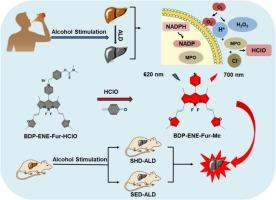基于BODIPY的新型近红外荧光探针通过观察HClO波动对酒精性肝病的诊断和治疗评价
IF 4.3
2区 化学
Q1 SPECTROSCOPY
Spectrochimica Acta Part A: Molecular and Biomolecular Spectroscopy
Pub Date : 2024-11-26
DOI:10.1016/j.saa.2024.125497
引用次数: 0
摘要
随着世界范围内饮酒者人数的增加,酒精性肝病(ALD)逐渐变得普遍,严重威胁着人类的身心健康。ALD在发生过程中往往伴有炎症的发生,炎症可诱导HClO等活性氧的高表达。在这项工作中,我们成功地制作了一个近红外荧光探针BDP-ENE-Fur-HClO,通过追踪HClO来实时成像酒精性肝病。该探针具有良好的灵敏度和特异性,识别速度快,近红外发射波长(700 nm),可用于HClO的体外检测。基于这些卓越的性能,探针能够在不受其他ROS干扰的情况下追踪活细胞和ALD细胞模型中的内源性/外源性HClO。此外,探针还可以监测正常小鼠体内外源性HClO的表达和腹膜炎小鼠体内HClO的高表达,从而完成炎症的诊断。建立了模拟危险饮酒ALD小鼠模型和模拟过度饮酒(一种酒精使用障碍)ALD小鼠模型,探针可以通过监测ALD小鼠体内HClO的波动来成像小鼠酒精性肝损伤,为ALD的诊断提供了一种有效的工具。最终,在给药后,探针可以很好地评价药物对ALD的治疗效果。本文章由计算机程序翻译,如有差异,请以英文原文为准。

Novel NIR fluorescent probe based on BODIPY for diagnosis and treatment evaluation of alcoholic liver disease via visualizing HClO fluctuation
Alcoholic liver disease (ALD) is gradually becoming common due to the increasing number of drinkers worldwide, which is a serious threat to human physical and mental health. In the process of ALD, it is often accompanied by the occurrence of inflammation, which induce high expression of reactive oxygen species including HClO. In this work, we successfully fabricated a NIR fluorescent probe BDP-ENE-Fur-HClO for real-time imaging alcoholic liver disease via tracing HClO. The probe displayed good sensitivity and specificity, rapid recognition speed and NIR emitting (700 nm) for detection of HClO in vitro. Based on the remarkable performances, probe was capable of tracing endogenous/exogenous HClO in living cells without interference from other ROS as well as in ALD cell model. Additionally, probe could monitor the exogenous HClO in normal mice and high expression of HClO in the peritonitis mice, that accomplishing the diagnosis of inflammation. What’s more, one simulated hazardous drinking ALD mice model and simulated excessive drinking (a type of alcohol use disorder) ALD mice model were developed, probe could image the alcoholic liver injury of mice by monitoring the HClO fluctuation in ALD mice, which affording a valid instrument for the diagnosis of ALD. Ultimately, after hepatoprotective drug administrating to the models, probe could triumphantly evaluate the treatment effect of drug on ALD.
求助全文
通过发布文献求助,成功后即可免费获取论文全文。
去求助
来源期刊
CiteScore
8.40
自引率
11.40%
发文量
1364
审稿时长
40 days
期刊介绍:
Spectrochimica Acta, Part A: Molecular and Biomolecular Spectroscopy (SAA) is an interdisciplinary journal which spans from basic to applied aspects of optical spectroscopy in chemistry, medicine, biology, and materials science.
The journal publishes original scientific papers that feature high-quality spectroscopic data and analysis. From the broad range of optical spectroscopies, the emphasis is on electronic, vibrational or rotational spectra of molecules, rather than on spectroscopy based on magnetic moments.
Criteria for publication in SAA are novelty, uniqueness, and outstanding quality. Routine applications of spectroscopic techniques and computational methods are not appropriate.
Topics of particular interest of Spectrochimica Acta Part A include, but are not limited to:
Spectroscopy and dynamics of bioanalytical, biomedical, environmental, and atmospheric sciences,
Novel experimental techniques or instrumentation for molecular spectroscopy,
Novel theoretical and computational methods,
Novel applications in photochemistry and photobiology,
Novel interpretational approaches as well as advances in data analysis based on electronic or vibrational spectroscopy.

 求助内容:
求助内容: 应助结果提醒方式:
应助结果提醒方式:


